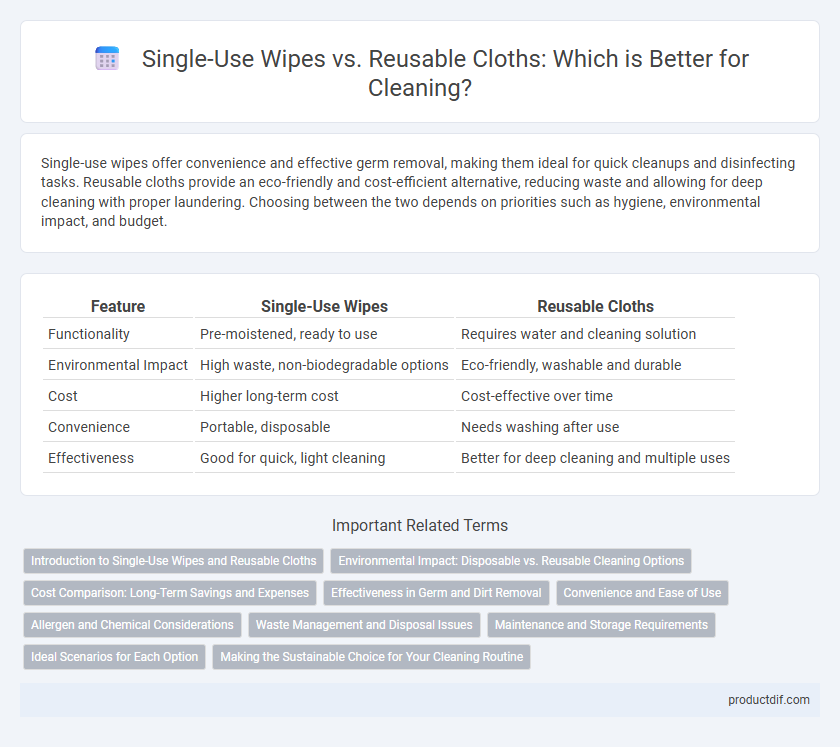Single-use wipes offer convenience and effective germ removal, making them ideal for quick cleanups and disinfecting tasks. Reusable cloths provide an eco-friendly and cost-efficient alternative, reducing waste and allowing for deep cleaning with proper laundering. Choosing between the two depends on priorities such as hygiene, environmental impact, and budget.
Table of Comparison
| Feature | Single-Use Wipes | Reusable Cloths |
|---|---|---|
| Functionality | Pre-moistened, ready to use | Requires water and cleaning solution |
| Environmental Impact | High waste, non-biodegradable options | Eco-friendly, washable and durable |
| Cost | Higher long-term cost | Cost-effective over time |
| Convenience | Portable, disposable | Needs washing after use |
| Effectiveness | Good for quick, light cleaning | Better for deep cleaning and multiple uses |
Introduction to Single-Use Wipes and Reusable Cloths
Single-use wipes offer convenience and immediate sanitation, often infused with disinfectants to eliminate bacteria and viruses on contact. Reusable cloths provide an eco-friendly, cost-effective alternative, capable of being washed and sanitized multiple times for repeated use. Both products serve essential roles in cleaning, with their choice depending on factors such as hygiene needs, environmental impact, and budget considerations.
Environmental Impact: Disposable vs. Reusable Cleaning Options
Single-use wipes contribute significantly to landfill waste and often contain non-biodegradable materials that harm the environment. Reusable cloths, made from sustainable fibers, reduce plastic pollution and lower carbon footprints by minimizing waste generation. Choosing reusable cleaning options supports circular economy principles and decreases the overall environmental impact of cleaning routines.
Cost Comparison: Long-Term Savings and Expenses
Single-use wipes often incur higher recurring costs due to constant repurchasing, whereas reusable cloths provide significant long-term savings despite an initial investment. Over time, the cost per use of reusable cloths decreases substantially as they can be washed and reused many times, reducing overall expenses. Factoring in environmental disposal fees and waste management, reusable cloths offer a more economical and sustainable cleaning solution.
Effectiveness in Germ and Dirt Removal
Single-use wipes offer convenience and consistent hygiene by being pre-treated with disinfectants that effectively kill a broad spectrum of germs and bacteria upon application. Reusable cloths, when used with proper cleaning agents and regularly sanitized, excel in removing dirt and grime but may harbor microbes if not properly maintained. For maximum germ and dirt removal, combining the immediate disinfection power of single-use wipes with the deep cleaning ability of reusable cloths after thorough laundering is most effective.
Convenience and Ease of Use
Single-use wipes offer unmatched convenience with their pre-moistened, ready-to-use design, eliminating the need for additional cleaning solutions and reducing preparation time. Reusable cloths require washing and proper maintenance, which can be time-consuming but provide long-term savings and environmental benefits. For quick, effective cleaning tasks, disposable wipes are favored for their ease of use and portability.
Allergen and Chemical Considerations
Single-use wipes often contain preservatives and fragrances that can trigger allergic reactions or skin sensitivities, making them less suitable for individuals with chemical sensitivities. Reusable cloths, when used with natural or hypoallergenic cleaning solutions, reduce exposure to harsh chemicals and allergens, promoting a safer cleaning environment. Choosing allergen-free cleaning products and thoroughly rinsing reusable cloths can further minimize chemical residues and potential irritants.
Waste Management and Disposal Issues
Single-use wipes contribute significantly to landfill waste and often contain non-biodegradable materials that complicate waste management. Reusable cloths, made from durable fabrics, reduce environmental impact by minimizing waste and allowing for multiple cleaning cycles. Proper disposal and recycling of cleaning materials are essential to mitigate pollution and improve sustainability in waste management systems.
Maintenance and Storage Requirements
Single-use wipes require minimal maintenance and can be disposed of immediately after use, making them convenient but creating more waste. Reusable cloths demand regular washing and proper drying to prevent bacteria buildup and maintain effectiveness. Storing reusable cloths in a dry, clean environment is essential to avoid mildew and odors, while single-use wipes need only dry storage before use.
Ideal Scenarios for Each Option
Single-use wipes provide convenience and hygiene for quick cleanups in high-traffic or medical environments where contamination risk is high. Reusable cloths offer durability and cost-effectiveness for routine household cleaning tasks involving less intense messes and require thorough washing between uses. Selecting the appropriate cleaning product depends on the balance of hygiene standards, environmental concerns, and cleaning frequency.
Making the Sustainable Choice for Your Cleaning Routine
Single-use wipes generate significant plastic waste and contribute to landfill overflow, making them less eco-friendly compared to reusable cloths crafted from sustainable materials like organic cotton or bamboo. Reusable cloths reduce environmental impact by allowing multiple washes, decreasing resource consumption and carbon footprint over time. Opting for biodegradable wipes or high-quality reusable cloths supports a greener cleaning routine and promotes responsible waste management.
Single-Use Wipes vs Reusable Cloths Infographic

 productdif.com
productdif.com